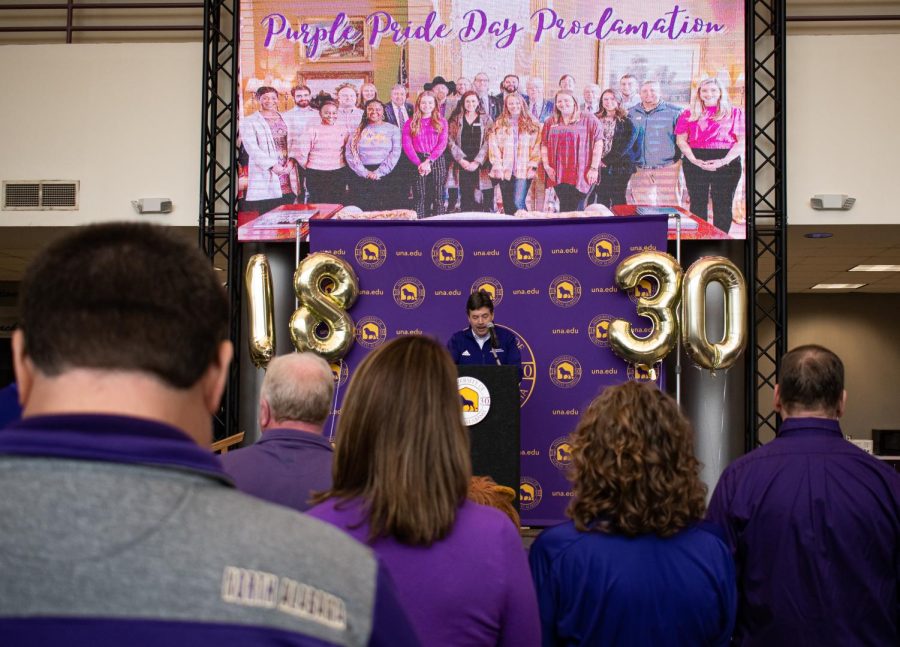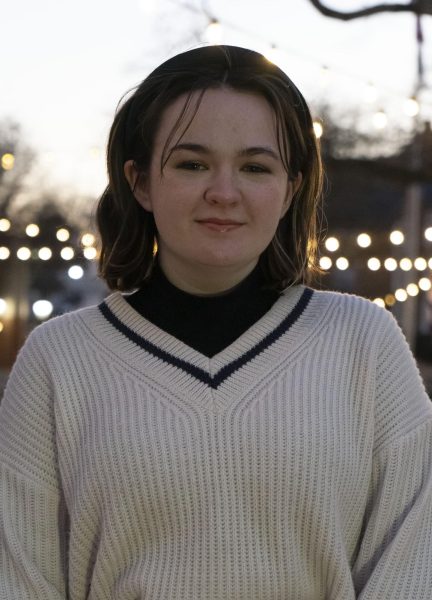UNA celebrates 193rd Founders’ Day
January 26, 2023
On Jan. 11, 1830, a small group of students stood on a hilltop, formally creating what is now known as the University of North Alabama. On Jan. 11, 2023, students gathered to listen to their stories in UNA’s Guillot University Center.
Associate Vice President of Student Affairs Dr. Tammy Jacques, President Dr. Kenneth Kitts, University Historian Dr. Jeffrey Bibbee and Director of Public Relations and Leadership Development for the Chamber of Commerce Olivia Bradford spoke at the event. The day also marks the beginning of Purple Pride Day, which the Chamber helped set in motion.
“I want you to take just a second,” said Kitts. “Let’s reach across time and space and feel that connection with that first cohort of students in 1830… Let us feel that connection with the women and people of color who were always there helping build the college, staff the college and who later on became students, faculty and staff in their own right.”
UNA is the oldest four-year institution in Alabama, as well as the fastest growing institution in the state. Enrollment just reached a record high of over 10,000 students. UNA has been home to many NFL players and musicians, boasting a fairly impressive alumni.
“Each of us are a part of the history of this institution,” said Bibbee. “…It’s that shared experience that started, like Dr. Kitts said, on LaGrange Mountain for just a handful of students on Jan. 11, 1830. [They] studied in what was still a very wild frontier. Their purpose was not that different from yours, they wanted to learn and make the mark that they would make on a very rapidly changing and evolving world. From that mountain, they watched the wilderness transform into farmland, they watched trains in the valley below transport Native Americans on the Trail of Tears.”
SGA President Amber Sandvig was in attendance.
“I am so honored that I am able to attend and actively be a part of the history that UNA has made as a campus,” said Sandvig. “I see a very bright future for our campus and I truly believe that we will continue to be an institution that encompasses many firsts.”
UNA has gone through many changes since its founding. On Jan. 11, 1830, it was known as LaGrange College. At the time it was a few miles from Leighton, Ala. The old site is preserved and able to be visited.
The college was founded by the Methodist church. According to Bibbee, in 1830, the greater Florence-Muscle Shoals area had recently been occupied by European-Americans. The land had previously been Cherokee land, though the area is close to the Chickasaw boundary.
“As the European population rose, they are needing to educate young men exclusively in several areas,” Bibbee said, “in part for service to the church, because the Methodist church is looking for preachers, but then also for those who will go into some form of business.”
LaGrange College was only accessible to young men from wealthy families. There was also a girls’ school further down on LaGrange Mountain, with a larger village. Since its infancy, UNA has been surrounded by community. The school was not large, but successful. It was attractive to prospective students from northern Alabama, southern Tennessee and northeast Mississippi.
In 1855, the campus moved to Florence. Part of the motivation was the presence of the First Methodist Church in downtown Florence. Despite having dormitories at the LaGrange site, there were none at the Florence site. Students boarded with local families, paying them rent and occasionally tutoring the young children of the house. The presence of the new influx of students created a more lively community in Florence.
The construction of Wesleyan Hall was the beginning of UNA as we know it. The name was changed from LaGrange College to Florence Wesleyan College. The LaGrange College site was abandoned not long before Union forces burned it down in the Civil War.
“[Burning LaGrange] was kind of a symbolic gesture because most of the students would ultimately be soldiers for the Confederacy,” Bibbee said. “There is a need to show dominance over the region as Union forces move in and out of this area.”
Wesleyan Hall was pivotal to the Florence area during the Civil War. Both Union and Confederate forces would occupy the lecture hall at different times. It also was used as a hospital.
When it was not being commandeered by militaries, the university remained open. There was a limited number of students and only one faculty member, Septimus Rice. Rice was charged with teaching every class in every discipline. Rice Hall now bears his name.
After the war, in 1871, the first group of women were allowed to attend Florence Wesleyan College. Edith Susie became UNA’s first female graduate.
The university saw rapid growth throughout the twentieth century. It underwent multiple name changes (State Normal School at Florence, Florence State College, Florence State University) before becoming the University of North Alabama in 1974.
The first African American student, Wendell Gunn, was admitted in 1963. The Wendell W. Gunn Commons now bears his name.
The university is not without a darker history. The name of Bibb Graves Hall, which sits at 601 Cramer Way, was changed due to Graves’ history with the Ku Klux Klan. It now is only referred to as Cramer Way.
In UNA’s nearly 200 year long existence, it has been witness to the rapid changes of the world, as well as changes of its own.





![Caleb Crumpton [COURTESY OF UNA SGA]](https://theflorala.com/wp-content/uploads/2024/07/caleb-crumpton-courtesy-of-SGA-425x600.jpg)






